Digging into parliamentary data
Feedbacks from 'TheLawFactory.fr' 2018 datasprint in Lyon
Post
From Wednesday June 27th 2018 to Saturday 30th, about 25 coders, social scientists, Member of the Parliament (MP) assistants, designers and political activists gathered with the SciencesPo médialab and Regards Citoyens teams at the Complex Systems Institute in the École normale supérieure de Lyon to work on the platform LaFabriqueDeLaLoi.fr and explore french parliamentary data, thanks to the financial support of LIEPP (ANR11LABX0091, ANR 11 IDEX000502) and IXXI.
The datasprint began with a collective brainstorm on the possible projects to be carried out during the workshop: many ideas were on the table and a lot could be explored during the 4 days.

We'll introduce here the projects that were carried out during the sprint.
Parliamentary assistants turnover
This project tried to explore the dynamics of hiring and firing of the 2555 parliamentary assistants (interns excluded) who worked at the French National Assembly during the first parliament session. We used this data to identify MPs global hiring practices, and to isolate questionable ones (i.e. changing their collaborators very often). Four indicators have been considered at the level of the MP: (a) the longest contract for all collaborators of the MP, (b) the number of contracts shorter than 6 months, (c) the ratio of the number of finished contract on the total number of contracts, and (d) a classical human ressources index: the turnover rate.
Although the global annual turnover rate of the National Assembly is close to the national one, 25% of French MPs have a turnover rate much higher than the average of small companies at national level. The most interesting findings of the investigation are: new elected MPs and women MPs are the categories with the shortest median length of collaborators contracts; some political groups have a significantly higher turnover rate (La République En Marche, and MPs without political affiliation) than others (Les Républicains, Nouvelle Gauche and La France Insoumise); men collaborators have shorter contracts than women and youngest MPs have higher turnover rates.
This work still in progress is available on its git repository here and has since led to a few publications in The Conversation, MediaCités and Regards Citoyens' blog.
Co-signature of amendments: alignment and fragmentation of political groups
Inspired by an unachieved old prototype experiment, this project worked on developing an interface to explore the alignment and fragmentation within the different political groups, as seen through the dynamics of co-signature or endorsing of identical amendments by different MPs.
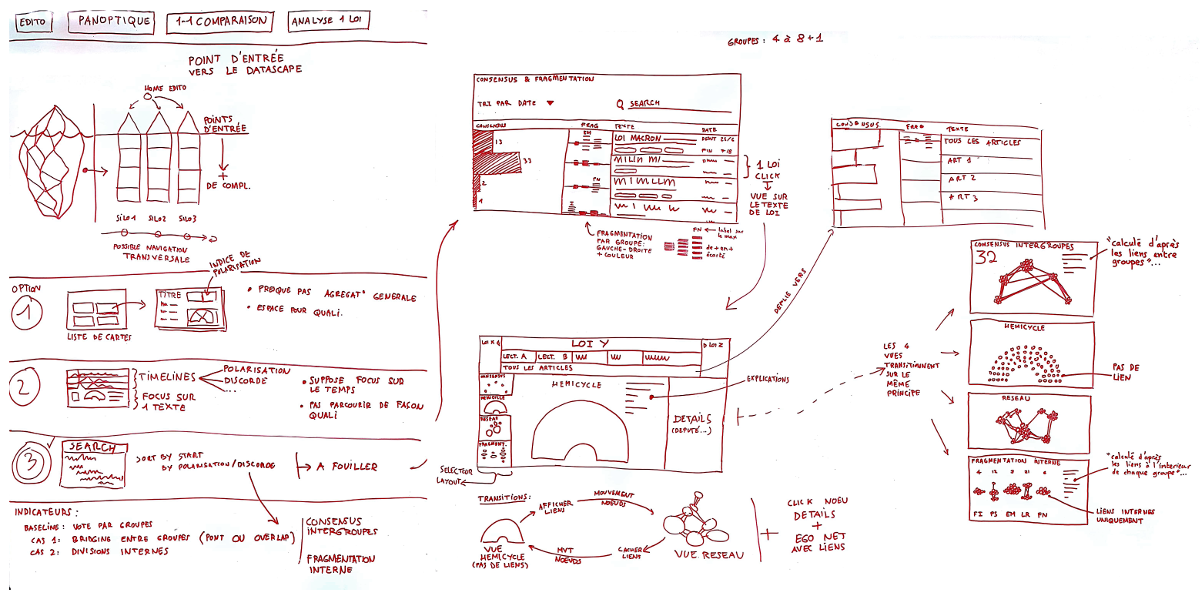
A first wireframe of an interface was built following the principles of datascapes so that it could either be an autonomous platform or integrated some day within TheLawFactory.fr platform. One can first explore all bills, qualified with two quantitative metrics reflecting for each specific text the consensus over all political groups on the text and the internal fragmentation within each one. One can then zoom deeper in and explore for each text 4 different network views, in which each node represent an MP and its proximity with others having signed common and identical amendments.
Still a prototype which would deserve a lot more improvements, the resulting platform built within the 4 days of sprint already revealed very promising!
Iframe https://player.vimeo.com/video/300314002?color=ffffff&byline=0&portrait=0
Classification and typology of amendments
In order to gain a better knowledge on the role of MPs into the law creation process, this project focused on the amendments proposed by MPs. Paving the way for quantitative analyses of these text modification proposals, it tried to establish a classification of amendments and align it with a combination of criteria on the series of variables that could be used to characterize each amendment (resulting status (adopté, rejeté, retiré, etc.), main author's origin (government, political group, rapporteur, etc.) number of authors, length of the text and motivations, bigrams identified within the motivations, similarity with other amendments, etc).
6 main categories of amendments were identified, described and attempted to automatically detect in this perspective: "redactional", "parliamentary guerilla warfare", "lobbying", "signaling", "consensus" and "lawmaking" amendments. Those are hypotheses yet to be tested. Both quantitative and qualitative analysis might output a different set of categories and would still need to be performed.
SedLex/DuraLex: automatic parsing and projection of amendments
This project led by our friends from LégiLibre and MaVoix intends to develop a logical grammar making it possible to parse the text of all amendments submitted at the French Parliement and automatically determine their effects on the bill to which they apply (i.e. how the law would change if the amendment was approved). The sprint was the occasion to improve the preexisting codebase and the rules of automatic detection. It paves the way for future integration of this technology in many possible projects such as TheLawFactory.fr
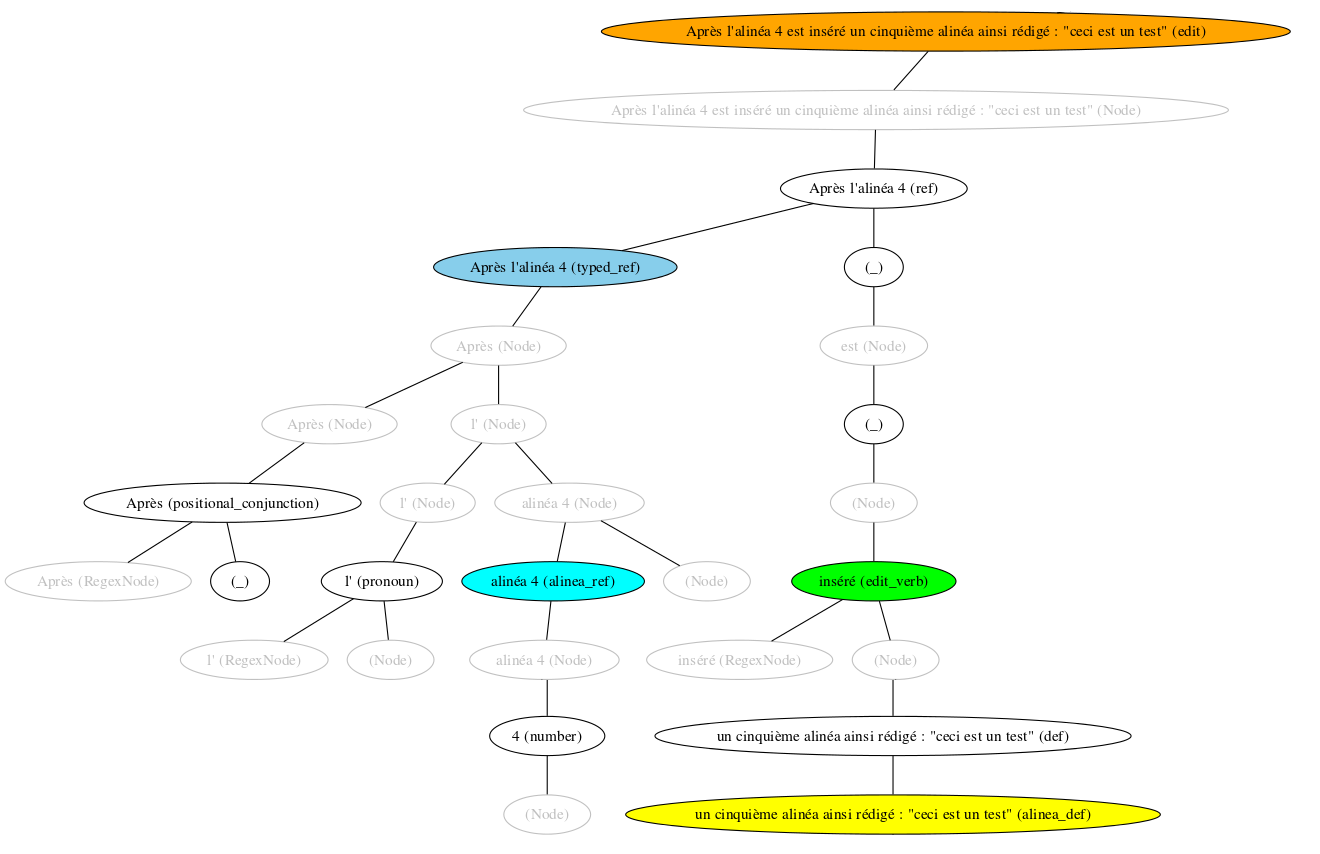
As a result, it is now possible with SedLex to automatically compute the resulting text after application of a series of amendments, as shown below in the DuraFront prototype available online.
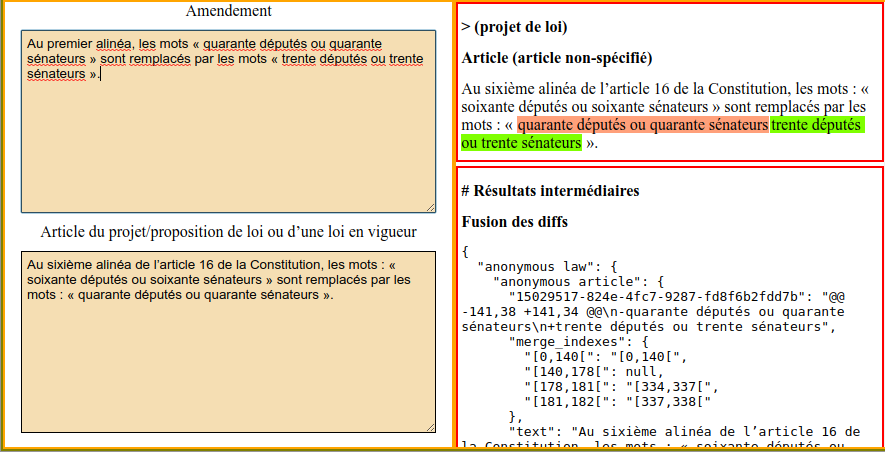
Debates captions analysis
The purpose of this project was to analyse the animation of the plenary debates through the captions included in the hansards (integral reports) of the National Assembly's debates (in the 15th legislature) and to provide information about the non-verbal interventions during the session of the Parliement (e.g. applauses, laughters, noises, etc.) as well as the tone of exchanges (protestations, approvals, invectives, etc.).
Dynamics between political groups and reactions to individual MPs or ministers were studied, revealing strong antagonism between mainly the majority group of LREM, and two opposition groups LR and LFI, and sharp differences of animation and intensity depending on the topics being debated. The analysis of individual actors also revealed recognizable roles within the arena of the assembly, such as "attackers" (representatives making a few speeches but a lot of interruptions), "heroes" (speakers which are attacked a lot but also loudly supported by their allies), "martyrs" (speakers attacked more than average), etc. Explorations to measure potential "manterrupting" (women abnormaly interrupted by men) did not reveal significant results.
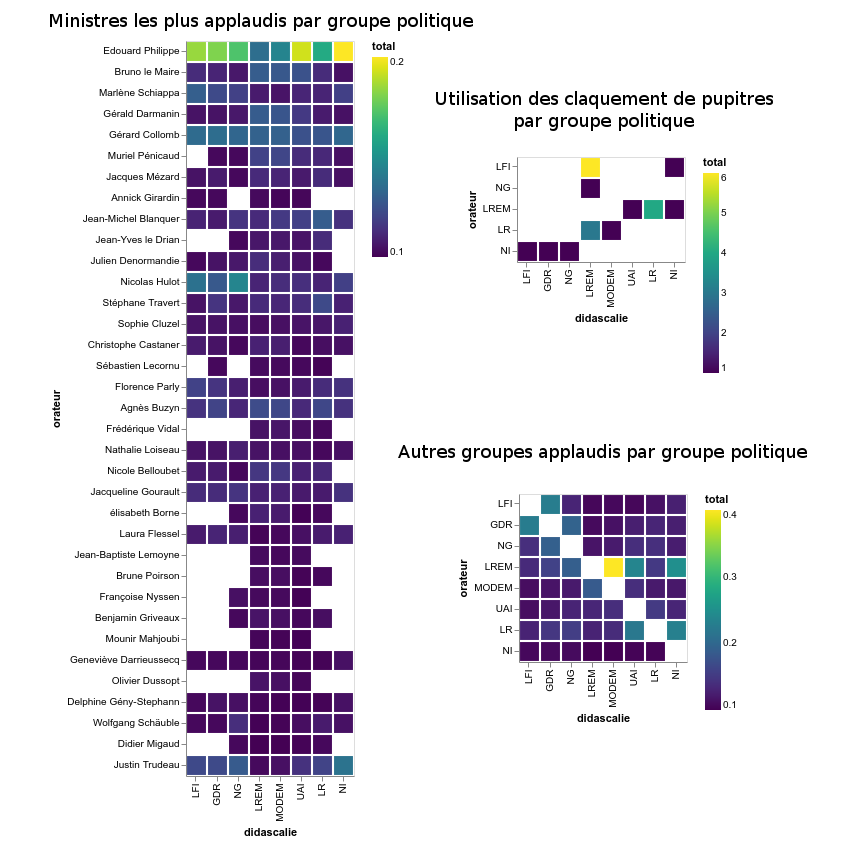
Another datascape prototype ("Rififi") was also built in a couple days from this first exploration in order to provide comparison elements between bills and between MPs based on this agitation analyses. For each bill, a few metrics (laughter, interruptions, speech circulation) were built and visualized globally and for each seance, allowing to replay the debate visually and identify patterns of agitated debates and MPs profiles.
Iframe https://player.vimeo.com/video/300311817?color=ffffff&byline=0&portrait=0
Votes alignment with the majority group
Inspired by WeDoData's work for the pureplayer media LesJours.fr, we worked on the National Assembly and Senate's OpenData of electronic votes to visualize how MPs aligned with the majority group over the first year of the current legislature. A first step leading towards the integration of these votes within NosDéputés.fr and TheLawFactory.fr in the future. This work already enables NosDéputés.fr to provide a better information on the actual presence of MPs within the National Assembly's hemicycle and still needs to be continued in order to list each MP's votes, measure their "rebellion" against their group and attach each vote to the corresponding amendment or text.
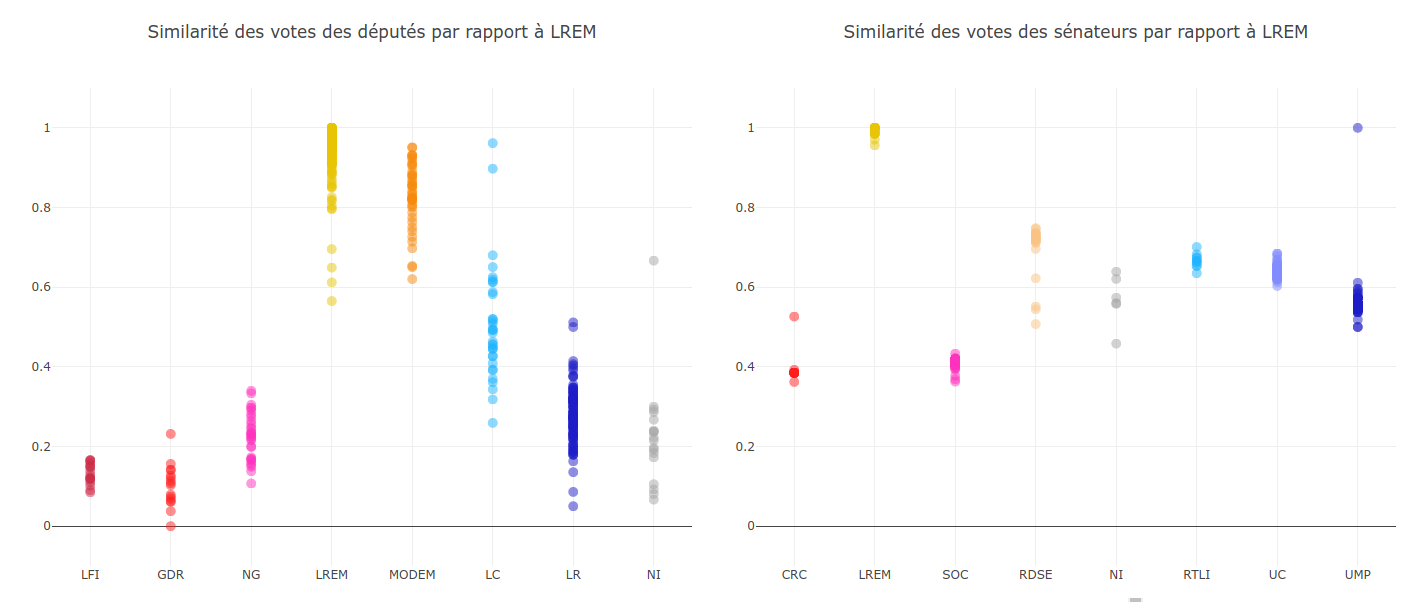
Pedagogical map of the french law making procedure
One of the core principle behind TheLawFactory project is to document the details and complexity of the french parliamentary procedure across all of its steps. The objective of this project was to design a legible chart to be used to explain to the visitors the complex journey that each law undergoes in the French Parliament from its first submission to its final promulgation. After having analysed this question in a more formalised way, we inventoried many past attemps to do so from official to mediatic ones, and tried then to design a more pedagogical chart to represent the procedure. It could still benefit from a real integration within the platform with dynamic interactions to get more explanations on the role, functioning and usage frequency of each steps.

Generation of a git repository for each bill #GitLaw
In order to extend Lawrence Lessig's metaphore "Code is Law" into "Law is Code", one of TheLawFactory.fr's initial aimes was to publish bills and their modifications through amendments as pieces of code versionned within a revision control system such as Git, seeing legislative steps as commits. Although, the whole refactoring of TheLawFactory since 2017 impacted it. The sprint was the occasion to reboot this feature and publish the texts already published on TheLawFactory within a dedicated GitLab repository, which still needs to be automatized.
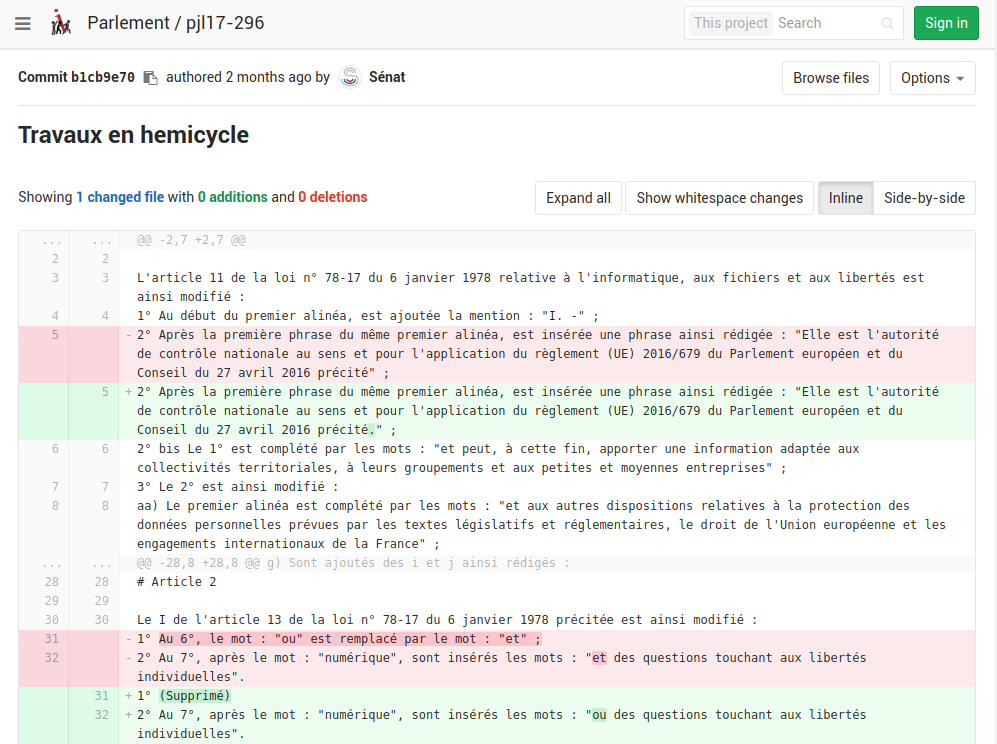
Finding texts in TheLawFactory by code referred
Thanks to the MetsLesLiens library developed at Parlement Ouvert, TheLawFactory now identifies within the text of the bills the references to existing codes and laws which are edited or referred to. This enables the possibility to use this data to filter bills and identify only those which have references to specific codes someone is interested in. So we added within the view of all bills, an option to filter by code, allowing to browse only bills which either edit or reference a specific code.
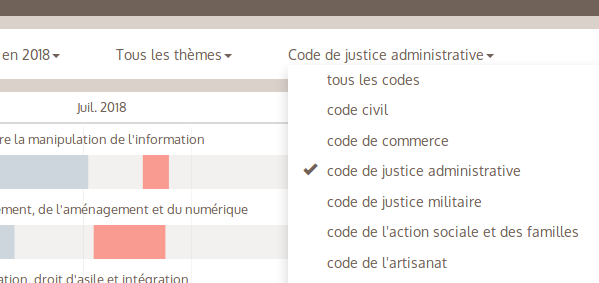
Routing service to link existing pieces of laws on LegiFrance
The identification of the codes quoted in the bills also permits to provide direct links to the referred articles of these codes directly from TheLawFactory's navigation interface. Although, the naive current approach of redirecting to the "I'm lucky" result of a DuckDuckGo search on the official LegiFrance websites often provides erratic results, and can at best return links to the present version of the law (which already contains the described modification from the bills and can therefore be slightly confusing). So it was proposed to build from the legislative OpenData a tool that could simply provide links to the official version at the desired date to any official bill. A first prototype (eli-router) answering calls to official laws identifiers (ELI) was developed during the sprint for this purpose. It should soon be made available on https://redirect.lafabriquedelaloi.fr and could be improved to answer also on actual law names such as "Article 7 du Code Civil" instead of ELI identifiers only.
More ideas!
Many more ideas were discussed, but could unfortunately not all be worked on. Here is a list of other discussions that were considered but not carried out during this session because of lack of time or competences:
- Preparation of a scientific paper presenting the interface of the platform as well as the dataset that it allows to explore. Despite the importance of such a piece of writing to encourage the use of the platform among academics and professionals, this project has been temporarily postponed and would benefit from contributions of potential or actual users (interested legal and political scholars, please get in touch!)
- Extraction and generalisation of the module of La Fabrique de la Loi that allows to compare two versions of the same article and reveal deletions and additions, so that it can be used for any text with different versions and sections (interested coders or hacktivists, please get in touch!)
- Rework the design of the homepage of the platform to make it more engaging for potential users (interested legal and political scholars, please get in touch again!)
- Enhancement of the articles view of the platform in order to allow the difference analysis to be applied to any two versions of the same text, and not only the two successive ones as currently proposed with this module.
- Production of a series of indicators for each bill and identification of trends on the practices of the French Parliement (e.g. time needed for adoption, number of discussion steps, time spent by bills in the Constitutional Council, respect of the procedure on legal delays, identification of the 'transpartisan' amendements, etc.) (interested political scholars and data journalists, please get in touch!).